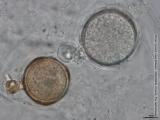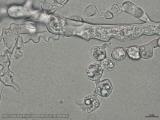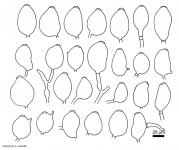Phytophthora austrocedrae
Phytophthora austrocedrae Gresl. & E.M. Hansen (2007) was isolated from necrotic lesions of stem and roots of Austrocedrus chilensis (Cupressaceae). It is homothallic with semi-papillate sporangia, oogonia with amphigynous antheridia, and very slow growth. It is the cause of “mal del ciprés”, a lethal disease of Austrocedrus in Argentina. Austrocedrus chilensis (ciprés de la cordillera) is endemic to southern Argentina and Chile. It is the most widely distributed tree species of the few conifers inhabiting the slopes of the Andes Mountains in Patagonia.
Etymology: ‘austrocedrae’ refers to Austrocedrus, the tree that is attacked by this pathogen.
Sporangia are borne terminally on mostly unbranched sporangiophores. Sporangiophores frequently have hyphal swellings. Sporangia are ovoid, limoniform or ellipsoid and semi-papillate. They average 50 x 36 μm (range 22-83 μm x 15-58 μm) with the length/breadth ratio about 1.4, and frequently have distorted shapes. Sporangia with hyphal projections and lateral attachment to the sporangiophore are frequently observed in all isolates. Sporangia are not observed in solid media.
Oogonia form in single-strain culture after about 20 days. Oogonia are globose or nearly so, averaging 39 μm diameter (range 22-56 μm), with hyaline to light brown, smooth walls. Oospores are globose, 31 μm diameter, hyaline, with smooth walls. Antheridiaare amphigynous and one-celled. Hyphal swellings usually form in liquid and solid media but are more abundant in the former. Swellings are globose to subglobose and catenulated, sometimes with distorted shapes.
The ITS sequence was identical to sequences of Phytophthora DNA extracted from bark of diseased trees. P. austrocedrae is in clade 8 of the Cooke et al. (2000) molecular phylogeny of the genus, with P. lateralis, another pathogen of Cupressaceae, and other aggressive pathogenic species. P. syringae is the closest described relative.
Phylogeny of P. austrocedrae based on ITS rDNA sequence analysis (Greslebin et al. 2007)
In V8 and tomato juice (TA) agar the colony was uniform, without growth pattern, cottony, dome-shaped in the center and appressed or mostly submerged at the margins. In corn meal agar (CMA) the colony was appressed, with little or no aerial mycelium and the submerged mycelia showed an arachnoid pattern. In potato dextrose agar (PDA) the colony was uniform, without growth pattern, densely felty to woolly, with abundant and dense aerial mycelium. Growth was very slow and favored by cool temperatures. Optimum temperature was 17.5°C, with no growth at 25°C.
Maximum radial growth rate at optimum temperature on V8 agar ranged from 1.0 – 1.8 mm/day.
Phytophthora austrocedrae is isolated from necrotic lesions of stem and roots of Austrocedrus chilensis. It is homothallic, characterized by semi-papillate sporangia, oogonia with amphigynous antheridia, and very slow growth with optimum temperature lower than most Phytophthora species. Phylogenetic analysis indicates that its closest relative is Phytophthora syringae, another species frequently isolated from soil and streams in A. chilensis forests.
The searchable web-based database Phytophthora-ID is useful for rapid identification of Phytophthora species based on sequencing of the ITS or Cox spacer regions, followed by BLAST searching the database. Phytophthora-ID maintains a database of sequences that is selective for sequence accessions that come from trusted sources including published, peer-reviewed studies whenever possible.
Updated Jan. 13, 2012
For more information about Phytophthora austrocedrae, visit our Disease, Education and Management materials, and Reference sections.









